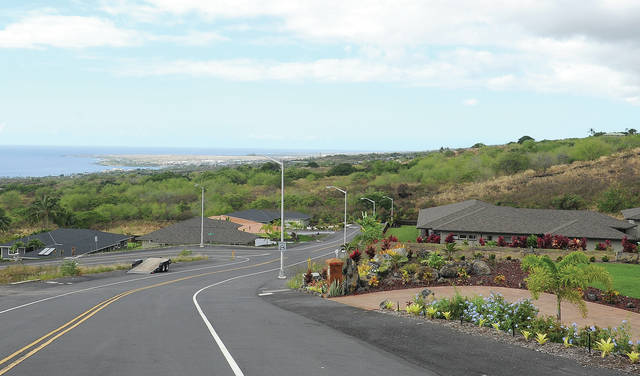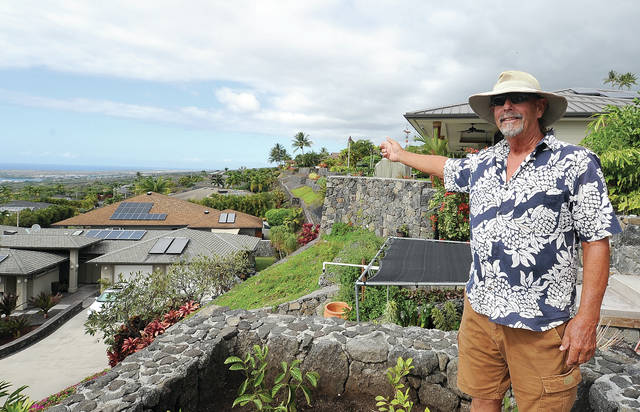KAILUA-KONA — A development expected to bring 450 units to Kailua-Kona is moving forward. Developers expect to file an application related to the project with the county’s Planning Department this week.
The almost 70-acre Kona Village development, which marks the final phase of the more than 173-acre Kona Vistas project mauka of Kuakini Highway that started in 1984, is expected to include 80 multi-family residential buildings with units planned both for rent and sale.
Zendo Kern, a planning consultant working with developer Kona Three LLC, said their goal for the project is to both meet the requirements of the Kona Community Development Plan and also offer housing options to the region’s workforce and medium-income families, “which Kona is in desperate need of.”
Bill Hall, a 30-year resident of the nearby Kona Sunset subdivision, said he’s trying to raise more community awareness about the planned development, however.
He said he’s concerned about the project’s impact on local infrastructure, particularly traffic in the surrounding neighborhood and the stretch of Kuakini Highway that runs below the area.
“If you’re going to put in 400 units, what are you going to do about the community impact?” asked Hall.
The Kona Village project represents the multi-family residential portion of the larger Kona Vistas project. In December 1983 the state Land Use Commission reclassified a little over 124 acres from agricultural land into the urban district and reclassified the remaining 49 acres about a decade later.
A 1984 county ordinance rezoned 103 of the acres to allow for single-family dwellings on lots at least 15,000 square feet in size. The remaining 70 acres were rezoned to allow for multi-family dwellings with a density of up to one unit per 5,000 square feet of land, according to an annual report filed with the state Land Use Commission.
Gamrex, the original developer, and its successor, Kona Vistas LLC, completed the development of the 103 acres, the annual report states, and as part of that process laid much of the groundwork for developing the last portion.
That included paying for water commitments for the entire water system for both portions, having the vast majority of the site covered by an archaeological inventory survey and providing a drainage master plan to the Department of Public Works.
That effort also involved the construction of the Lako Street-Kuakini Highway intersection and Lako Street extension and getting a 12-acre parcel outside of the area to satisfy an affordable housing requirement for the development.
Now the developer is looking toward the final phase of the project, which is being eyed for multi-family housing — specifically 450 units across 80 buildings.
This coming week, Kern said, they’ll be submitting an application for a time extension for the zoning to the county Planning Department.
That application will eventually go before the Leeward Planning Commission and then the County Council. Once the application gets out of the county council, he said, groundbreaking can get underway.
According to the master plan for Kona Village, the project’s 80 buildings include both two-story buildings with four units each and three-story buildings with six units each.
Of the total units, 176 units would be rental units while the other 274 would be for sale, according to the plan.
Hall, who is looking to raise community awareness about the development, said he’s concerned about the impact the development would have on the local infrastructure, particularly the roads.
And given what the developer stands to gain from the project, he said the community ought to reap some benefit from developments such as this.
“I think when a developer’s going to impact it,” he said, “it’s an opportunity for the community to benefit.”
He said his suggestion would be for the development to move away from building the multi-family units to reduce the density of the final project.
The master plan includes reference to the construction of connections between Paulehia Street and Kekuanaoa Place and between Hoomama Street and Leilani Street. Kern said that’s per the Kona Community Development Plan’s transportation guidelines.
Currently, access to the area is planned to be via Puapuaanui Street and Lako Street, Kern said.
Asked about plans for a new connection from the highway, Kern said they’re “exploring it.”
“Our goal is to work with the community and make it a good project for that area,” he said.
The roughly 12-acre affordable housing parcel is located just makai of the highway at the top of Royal Poinciana Drive.
According to county records, the site is currently registered to a holding company at the same address as Kona Three.
Kern said the 12 acres will be deeded over to the county likely around the same time the county council considers the timeline extension.
“We’ll do what we need to do to make it shovel-ready for the county,” said Kern. “So when the county gets it they can basically go forward and develop it or partner with a developer to develop the affordable housing.”







I am sure Eoff has got her Dusty Old Taco in this somehow and will end up with some “Vacation Rentals”.
This development represents a very poorly planned addition to housing in Kona. The type of housing is inconsistent with surrounding neighborhoods, and without direct access to the highway, those surrounding neighborhoods will experience multiple orders of magnitude increase in street traffic, noise, trash, and wear and tear. The developer needs to sharpen their pencils on this one.
What a perfect place to put village 9 and a few hundred Tiny home like in Puna only permanent, we can call them transitional because V-9 camp is there. Maybe the homeless people can observe how the rich people of kona in that part of town live and work, thus change there ways.
Gasp!
I’m here now so no one is allowed to change anything!!
After all, I invented…. I did….
Well anyway, I’m here and I’m important!!
Haa, Haa, Haa,
and I have a bridge from Hawi to Hanna to sell’ya, cheap.
The landowner (via the prior owner who got the property zoned for exactly this density 35 years ago, has already paid and paid and paid for community benefits for ALL of the zoned land, as this article states above. This is unlike other proposals where the developer has done nothing and wants a free ride. Also, the density and interlinkage with Pualani Estates and Kona Vistas (Lako to Puapua’anui) is exactly what the Kona Community Development Plan lays out in black and white, as well as this higher density, so that an urban center can eventually emerge in this area. This is not about what pleases Kona Vistas owners on big lots, it’s about funneling Kona’s inevitable growth into more compact nodes (and this is one of them according to the Plan), with interlinking streets that can support better transit options off the main highways.
What’s missing from this large scale planned development? Solar, batteries, and a dedicated microgrid designed to serve the energy needs of the anticipated community build out. Couple this reliable clean energy supply to higher building efficiency standards and affordable clean energy options and sustainability no longer remain the missing elements in Hawaii County’s planning and approval of large scale residential and commercial developments.
This is a no brainier. The County should use all the extra taxes and profit from property tax increases, gas taxes, sewer fees, water increases etc to put the infrastructure in and fund the winding of the highway from Kona to Keauhou and Helco should use some of their massive profits to provide electricity connections a lower cost so that they can have more customers to gouge.
The building of this probably generates 150 million dollars of activity to tax, then the development probably generates 2 million dollars a year in ongoing tax and fee revenue. We get a way to get between Kona and Keauhou quicker. This is in an urban area and provided the architecture is attractive that’s a win!